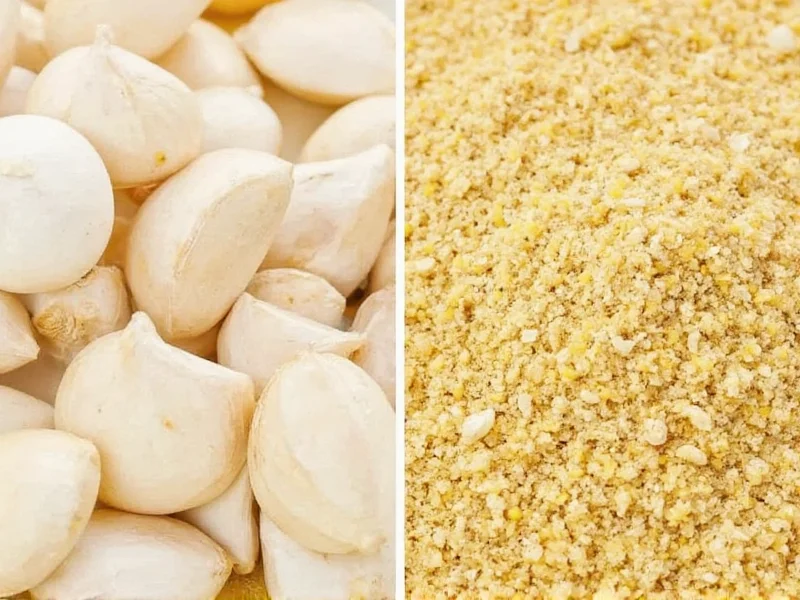Understanding the distinction between these two common garlic forms is essential for achieving perfect seasoning in your cooking. While both originate from dehydrated garlic cloves, their processing methods create significant functional differences that impact how they behave in recipes.
Physical Characteristics Compared
The most fundamental difference lies in particle size. Garlic powder undergoes extensive grinding to achieve a fine, flour-like consistency where particles measure less than 0.5 millimeters. This fine texture allows it to dissolve almost completely in liquids. Granulated garlic, by contrast, maintains a coarser structure with particles ranging from 0.5 to 1.5 millimeters—comparable to fine sand or table salt.
| Characteristic | Garlic Powder | Granulated Garlic |
|---|---|---|
| Particle Size | < 0.5 mm (flour-like) | 0.5-1.5 mm (fine sand) |
| Moisture Content | 4-6% | 6-8% |
| Flavor Intensity | Stronger (more concentrated) | Milder (more subtle) |
| Solubility | Dissolves quickly | Dissolves slowly |
| Texture Contribution | None | Slight |
Production Process Differences
Both products begin with fresh garlic cloves that undergo peeling, cleaning, and slicing. The critical divergence occurs during dehydration and milling. Garlic powder production involves extended drying to reduce moisture content below 6%, followed by thorough grinding through fine mesh screens. Granulated garlic receives a shorter drying cycle (retaining slightly more moisture) and passes through coarser screens during milling, preserving its distinctive texture.
Flavor Profile and Culinary Performance
Garlic powder delivers more intense flavor due to its higher surface area-to-volume ratio, which allows volatile compounds to release more readily. This makes it ideal for dry rubs, spice blends, and applications where immediate flavor impact is desired. Granulated garlic provides a more gradual flavor release, making it preferable for longer cooking processes like soups, stews, and braises where you want garlic flavor to develop gradually.
When dissolved in liquids, garlic powder creates a more uniform flavor distribution, while granulated garlic maintains slight textural elements that can be desirable in certain applications like salad dressings or marinades where subtle texture is acceptable.
Substitution Guidelines
Understanding how to substitute granulated garlic for garlic powder requires attention to ratio and timing. Use a 2:1 ratio when substituting granulated for powder (2 parts granulated = 1 part powder) due to the concentration difference. For the reverse substitution, use half the amount of powder compared to granulated garlic.
When replacing fresh garlic with granulated or powder, remember that 1/8 teaspoon of garlic powder equals one fresh clove, while 1/4 teaspoon of granulated garlic equals one fresh clove. The moisture difference affects how these ingredients interact with other recipe components—powder absorbs liquids more readily, which can impact sauce consistency.
Optimal Storage Practices
Both forms require airtight containers away from light and moisture, but garlic powder's finer texture makes it more susceptible to caking and flavor degradation. Properly stored in glass containers with oxygen absorbers, garlic powder maintains peak quality for 18-24 months, while granulated garlic lasts 24-36 months due to its slightly higher moisture content acting as a natural preservative.
Common Misconceptions Clarified
Many home cooks believe garlic salt and garlic powder are interchangeable—they're not. Garlic salt contains approximately 3 parts salt to 1 part garlic powder, making direct substitution impossible without adjusting overall salt content. Similarly, the assumption that minced garlic in oil equals dried garlic products is inaccurate—fresh preserved garlic has different flavor compounds and moisture content that significantly alter recipe outcomes.
Practical Application Guide
Choose garlic powder when you need:
- Immediate, intense garlic flavor
- Complete dissolution in sauces and dressings
- Dry rubs for quick-cooking proteins
- Seasoning for popcorn or snacks
- Gradual flavor development in slow-cooked dishes
- Slight textural element in dressings
- More forgiving measurement (less potent)
- Longer shelf stability
Cost and Availability Considerations
Garlic powder typically costs 15-20% more than granulated garlic due to the additional processing required. However, because you use less powder to achieve equivalent flavor, the cost per serving often balances out. Specialty brands offering organic or sprouted garlic products show wider price differentials, with powder sometimes costing up to 30% more than granulated versions.











 浙公网安备
33010002000092号
浙公网安备
33010002000092号 浙B2-20120091-4
浙B2-20120091-4